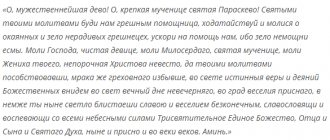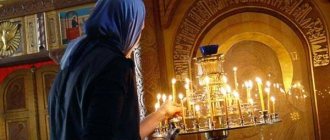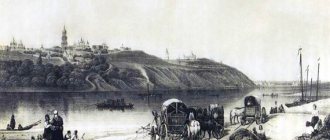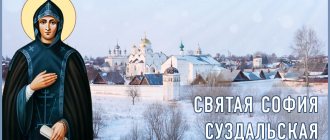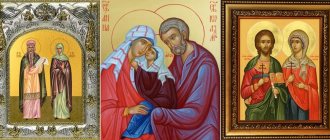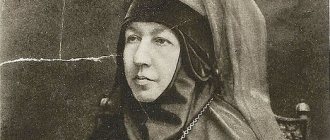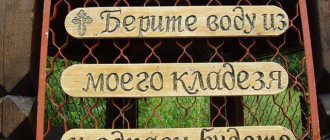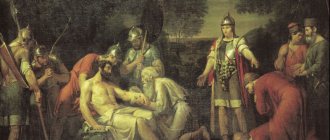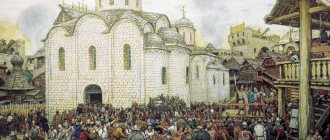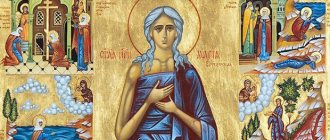| Igum. Paraskeva (Rodimtseva) |
Paraskeva (Rodimtseva)
(1849 - 1928), abbess of the Toplovsky Monastery, Venerable Memory of December 3 (Simfer.)
In the world, Olga Ivanovna Rodimtseva was born in 1849 in Moscow into a pious merchant (according to other sources, bourgeois) family.
In 1871, at the age of 22, she entered the Moscow Passion Monastery.
In 1874, she was identified as a sister and clothed in a ryassophore with the name Vyacheslava.
In 1875, the abbess of the Passionate Monastery Valeria (Bode) received the blessing to move to the Toplovsky Monastery and wished to take the nun Vyacheslava with her. Faithful to monastic obedience, she happily agreed.
In the Toplovskaya monastery, nun Vyacheslava from the very first days showed herself to be a zealous ascetic, seeking strictly monastic work. Constant exercises in fasting and prayer, reading the Holy Scriptures and the Holy Fathers bore fruit. Her sobriety and prudence were noted by the sisters, and her wise stewardship by the clergy. And soon, with the unanimous approval of the nuns, she was elected secretary of the monastery council, and later treasurer.
On June 16, 1889, she was tonsured a monk and given the name Paraskeva by Bishop Martinian (Muratovsky) of Tauride.
In December of the same year, she was appointed abbess of the monastery, and on July 26, 1890, she was elevated to the rank of abbess.
Mother led a strict ascetic life, prayed unceasingly, was meek, non-covetous and hospitable. Through the labors and prayers of the Venerable Paraskeva, the Toplovskaya monastery was established, the three-altar Holy Trinity Cathedral was built, as well as other churches on monastery farmsteads in Feodosia, Simferopol, Old Crimea and Kerch, and many church and utility buildings. Thanks to significant donations, an orchard was laid out in the monastery, and two farms were organized for household needs. In 1897, on the initiative of Abbess Paraskeva, a hospital with a house church was erected in honor of the icon “Joy of All Who Sorrow.” A separate house was built for the clergy, as well as a small church and school at the Kazan courtyard in Feodosia.
After the revolution, all the lands and gardens that were so successfully cultivated by the sisters of the monastery were transferred to the state. A “Soviet sanatorium” was organized on the territory of the monastery. In order to preserve the statutory monastic life of the monastery, Abbess Paraskeva proposed the creation of a women’s agricultural artel, which later received the name “Women’s Labor” and was registered in 1922. This wise decision saved the monastery for some time. As before, the Divine Liturgy was celebrated daily, and the sisters carried out the usual obediences. The abbess said to her closest assistant, nun Polyxenia (Shlyakhova): “Watch carefully so that not one of the monastic laws contained in the teachings of the apostles and the tradition of the holy fathers is forgotten. Keep holy the blessed and unanimous community"
.
| Icon of St. Paraskeva Toplovskaya |
The atheists turned to the Crimean Central Executive Committee with a request to “approve the liquidation of the churches of the former Toplovsky Monastery,” and the churches were sealed. The believers of the surrounding villages opposed this and submitted an application to the Crimean Central Election Commission for the return of the sealed churches. The spiritual uplift was so great that one can speak without exaggeration about the feat of confession of ordinary peasants who decided to stand up for their shrines. The atheists knew that Abbess Paraskeva was behind all this, but they could not do anything. The churches were not opened, but the believers did not give up. According to spiritual reasoning, the abbess and her sisters decided to ignore the ever-increasing pressure from the authorities and threats of possible reprisals; their main attention was focused on internal work. The abbess taught the sisters “to be always ready to die for the faith of Christ, for the purity of the teachings of the Orthodox Church of God”
and said that she was
“confident in the Lord that each of you, both old and young, by the grace of the Holy Spirit will never betray the saint in one iota.” Orthodoxy, will accept torture and even death for all the truth of God.”
On September 7, 1928, the authorities liquidated the Women's Labor agricultural artel.
Abbess Paraskeva died on December 16, 1928 from cardiac paralysis, having been ill for only an hour and a half. Before her death, she confessed and received the Holy Mysteries of Christ. Abbess Paraskeva was buried in the monastery cemetery. But her grave was plundered by “treasure” seekers. In the early 1980s, workers wanted to take a monument from the monastery cemetery for a mass grave. But when the tombstone was lifted and turned over, it turned out that it belonged to Abbess Paraskeva, as evidenced by the words: “Here lie the honest relics of Abbess Paraskeva. The prayer candle of her soul burned for half a century with great and fiery love, with petitions for the monastery of this saint to the Lord. We love, we bow to you, our kind and wise mother. 3. XII. 1928 (O.S.)"
. Now the tombstone is inside the chapel.
Abbess Paraskeva was canonized as a locally revered saint of the Simferopol diocese by the decision of the Holy Synod of the Ukrainian Orthodox Church on March 25, 2009. Remembrance Day is set to take place on December 3. On July 11, 2010, the solemn glorification of the holy Venerable Paraskeva of Toplovskaya took place. The rank was headed by Metropolitan of Kiev and All Ukraine Vladimir (Sabodan). On the day of glorification, July 11, the memory of St. is also celebrated at the Toplovskaya monastery. Paraskeva [1].
The relics of the saint were found and underwent an examination, which fully confirmed their authenticity. Now they are in the Paraskevi temple of the monastery.
Prayers
Troparion, tone 4
Our venerable mother Paraskeva, / you despised the wealth and glory of this world, / from your youth you were disheartened by the most beautiful Christ above all, / the cross to the ground and from it did not even descend to death Further./ You brought purity of soul and body to the Lord as a gift,/ through bloodless suffering to Him You have pleased us:/ You are now in the Heavenly abode,/ Remember us who honor your glorious memory.
Troparion, tone 1
From your youth you were ignorant of Christ/ and to Him alone you worked, God-wise Paraskevo./ When the predatory God-fighters surrounded your God-saved abode,/ crowned with the feat of confession Thank you./ Likewise, instruct us in virtues with love to stand firmly/ in the Orthodox faith and piety.
Kontakion, tone 2
You dwelt in the monastery of Toplovstey, blessed Paraskeva, / you despised worldly rebellion and human deceit. / Likewise, God exalted you in times of fierce persecution. / Strengthen the faint-hearted and protect the mouth of those who blaspheme the Holy Church, / deliver us from all evils found / through your prayers and with tenderness those who call:/ Rejoice, praise and affirmation of our earth.
Prayer to Venerable Paraskeva Toplovskaya
Oh, our reverend and wise mother Paraskevo! In this temporal life, you have become accustomed to working unceasingly for Christ, you have remained everlasting in obedience, fasting and prayer, you have lived a godly life and won an unfading crown of glory! Accept this small prayer of ours, offered to you with love and tears. Enlighten our darkness with the bright rays of your divine virtues. Pour upon us, your children, the oil of your mercies and blessings. Soften the scabs of sin, heal the wounds of soul and body, visit and console those who are infirm. Oh, our blessed and meek mother, do not leave us orphans! And just as you did not leave your abode after your dormition, being there in body and soul in heaven, so now do not leave us in the virtue of the poor. Deliver us, by your omnipotence, even to God, by intercession from the troubles and temptations that come upon us today through our sin. Beg the Lover of Mankind, Christ, to grant us remission of sins, so that we may pass through this temporary life without restraint and enter into eternal joy with all the saints. Amen.
Holy Trinity Paraskevievsky Toplovsky Convent Monasteries of the UOC MP
With the blessing of Bishop Alexy, on September 17, 1862, a construction committee was formed, which was supposed to find funds and begin building a temple at the source. The committee consisted of the rector of the Kiziltash cinnovia, hegumen Parfeniy (killed by the Tatars on August 22, 1866), a priest from the village of Sala (now the village of Grushevka) Ioann Novitsky, the Kishlava churchwarden Job Uzunbeev and the Kishlava sexton Stefan Miho. Abbot Parthenius was given a collection book for donations from the consistory, and sexton Miho was supposed to look after the building materials.
Funds for the construction of the church were collected very quickly, and already in May 1863. The construction committee began construction of the temple, which was built in an unprecedentedly short time, almost two months, and was completely finished by July 22 of the same year. The construction was carried out so quickly thanks to the extraordinary energy and economic activity of the Kiziltash abbot Parthenius. He created in a short time from a poor monastery a prosperous monastery in the name of St. Stephen of Sourozh, and now, with the blessing of Bishop Alexy, he helped the new monastery, often coming here on horseback through the mountains from Kiziltash. The first monastery church in the name of St. Martyr Paraskeva is, to some extent, a monument to Abbot Parthenius, who suffered a martyr’s death at the hands of murderers.
The temple turned out to be small, with an area of only 5 square meters. fathoms, but this was enough for that period. It was surrounded by a covered gallery where worshipers stood. The floor in the temple was wooden, and in the gallery - clay, the nuns repaired it every week, smoothly filling cracks and potholes. His Eminence Alexy ordered that church utensils, priestly vestments and a bell weighing 12 pounds, from things collected by the wanderer Andronik, later a monk of the Kiziltash monk, be transferred to the church. The construction committee purchased the other two bells in Simferopol. Clothes for the throne and altars were issued from the bishop's Cross Church.
On the day of remembrance of St. Venerable Martyr Paraskeva, July 26, 1863, Vladyka Alexy, in front of a large crowd of people, solemnly consecrated the newly built church, and from that day services began in it.
In 1887, with the blessing of Bishop Martinian, the church was rebuilt and enlarged according to a plan drawn up by civil engineer Agienko. The through gallery surrounding the temple was surrounded by a stone wall and directly connected to the church. July 24, 1888 His Eminence Martinian re-consecrated the rebuilt church. In the same year, a new stone bell tower covered with iron was added to the church; the crosses with balls on the church and bell tower were gilded. The iconostasis in the church was also refinished: it was painted light pink and gilded. In front of the choirs, two small side iconostases were erected, also painted with gold. T.I. Malchevskaya donated 300 rubles for the installation of these iconostases.
During Soviet times, the temple, like the entire monastery, was closed and suffered greatly. During the years of the revival of the monastery, restoration work was carried out in the temple, the walls were decorated with paintings, and services are held in the temple.
Paraskeva Toplovskaya what they pray for
Abbess Paraskeva, in the world Olga Ivanovna Rodimtseva (1849-1928), was the abbess and ruled the Toplovskaya monastery from 1889 to 1928. She was originally from Moscow. She received her education at the Moscow Philistine School. At the age of 22, Olga entered the Moscow Passion Monastery, where in 1874 she was identified as a sister and clothed in a ryasophore with the name Vyacheslava. When the abbess of the Passionate Monastery, Valeria, expressed a desire to move to the Toplovsky Monastery, the novice Vyacheslav arrived with her in Crimea in 1875. After Abbess Valeria left the monastery, Vyacheslava did not follow her, but remained in the monastery and was elected secretary of the monastery council, and later treasurer. In 1884, for her excellent and useful service, she was given the blessing of the Holy Synod and given a certificate. On June 16, 1889, Bishop Martinian tonsured her into monasticism with the name Paraskeva, in December of the same year she was appointed abbess of the monastery, and on July 26, 1890, on the day of remembrance of the Venerable Martyr Paraskeva, her heavenly patroness, she was elevated to the rank of abbess.
For thirty-nine years, Abbess Paraskeva ruled the Toplovskaya monastery; before her eyes and through her efforts, the poor monastery turned into a strong, well-established economy. For her work for the benefit of the monastery, in 1894 Mother Paraskeva was awarded the highest award that monastic women can have - the pectoral cross.
In 2009, by the decision of the Holy Synod of the Ukrainian Orthodox Church, Mother Abbess Paraskeva Rodimtseva was canonized and canonized. A service was compiled and an icon of the saint was painted. On July 11, 2010, the glorification of Mother took place, led by His Beatitude Metropolitan Vladimir of Kiev. The relics of the saint were found and underwent examinations, which fully confirmed their authenticity. Now they are in the Paraskevievsky temple of the monastery. The memory of the Venerable Abbess Paraskeva Toplovskaya is celebrated on December 16.
Crimea is filled with legends. You especially feel this when you approach the Toplovsky Monastery. Here, according to legend, the Venerable Martyr Paraskeva Friday was executed. To get to the monastery you need to climb for a long time along a dusty, steep, snaking road, around which unusually tall, fabulous trees stood like a thick wall in the calm, without moving. The monastery amazes with its light, openwork beauty, clear, sonorous air, picturesque hills and paths. Involuntarily, a person is overcome by a slight euphoria (as it should be in high mountains, according to medical information). Even elderly people, almost without shortness of breath, touchingly holding hands, walk along steep mountain paths - then to the source of St. St. George the Victorious (again legend: in ancient times people saw here in the mountains a horseman with a familiar iconographic spear), then to the cave of the actual founder of the monastery - the Bulgarian Constantine.
The holiness and grace of the place is felt immediately. And Saint Paraskeva heals everyone here. The saint was born in Rome in the 2nd century. Her Christian parents did not have children for a long time and through their prayers they asked the Lord for their only child - a daughter, who was named Paraskeva in honor of her birthday - Friday in Greek. After the death of her parents, having distributed property to the poor, Paraskeva left the world and devoted herself to preaching the Gospel of Christ to the pagan peoples. In Rome, the center of paganism and pagan education, she was honored to endure her first suffering for the name of Christ and converted many pagans to the Christian faith.
Sources
There was a spring at the execution site. The same one to which many suffering and ailing people go. The holy spring is decorated with local granite, and there is a chapel with an iconostasis near it. On July 25, on the eve of the temple holiday, many people gather here for the All-Night Vigil: they come from surrounding villages and come from afar.
Nearby is a closed marble bath, into which two more healing springs flow from the mountains - St. George the Victorious and the Three Saints. A huge white marble Angel pours water from a jug into the bathhouse. Water from the source of St. Paraskeva Pyatnitsa helps well with eye diseases. It is not for nothing that on the icon we see St. Paraskeva with a dish in his hands. There are human eyes in the dish. This is her gift to us - let us see clearly. They gain their sight both spiritually and physically. One woman lost all her eyelashes and her vision began to deteriorate; doctors could not help. She arrived at the monastery, and only the source of St. Paraskeva Pyatnitsa helped her restore her vision. The other two sources help with joint diseases and nervous diseases. The springs are famous throughout Taurida; not only Christians come here..
The monastery keeps a notebook in which cases of healing are recorded. Here are just a few entries from the notebook.
“September 2000. Several years ago, the father of one family became seriously ill. His daughter prayed to the Lord: “Lord, don’t take your father, share the disease for me too.” And then she felt bad. She was admitted to the hospital, and after the puncture was taken she did not rise. Diagnosis: multiple sclerosis. She was bedridden for six years. Dried up. There are only bones left. On the Feast of All Who Sorrow, Joy of All Who Sorrow, I, unworthy Vasilisa, brought her to the Toplovsky Monastery - the Lord vouchsafed me. After plunging into the Holy Font, sick Elena got to her feet and walked. She also regained her ability to speak. We thank the Lord and Mother of God for the miraculous healing. Adamov, Sevastopol.
Story. There were legends
Officially, the Toplovsky Convent of St. Paraskeva was founded at the request of Tauride Bishop Alexy on September 25, 1864. But the folk legend and at the same time the heroic deeds of the people, like stones, lie at the foundation of the monastery of St. Paraskeva. Since the late 50s of the 19th century, near the village. There lived a pious Bulgarian girl named Konstantina in Toply, Feodosia district. Hearing the Heavenly voice, she left home and became a hermit, remaining in fasting and prayer. She lived in a cave for seven years, her clothes were rags.
I had the opportunity to visit this cave, which all pilgrims consider it their duty to visit. Many people believe that they visited the nun Konstantina. But it is not so. Her cave, dug with her own hands, has not survived. The cave was quite small, so that Konstantina could barely fit into it, sheltering from the cold at night. The current cave is a long, rather narrow and cramped passage, lined with icons, candles and burning lamps. The walls are damp, with hanging drops of protruding dew. And yet it is easy to pray here, the grace is extraordinary. This cave was cut down already during the existence of the monastery. Here the schema-nice prayed in solitude. Then from the cave of Constantine she moved to the source of St. Paraskeva, where she settled in a dugout. First alone, and then several women joined her. There was a chapel above the source, but Konstantina prayed day and night that a real church would be built. At the end of her life, Konstantina took full monastic vows and was named Paraskeva. She became the first abbess of the monastery and died at a ripe old age in 1874.
The next significant figure in the history of the monastery was Abbess Paraskeva, in the world Olga Rodimtseva, from a merchant family. Having become abbess, Paraskeva achieved prosperity at the Toplovskaya monastery. Not a single Crimean monastery has donated as much as to the monastery of St. Paraskeva. For her work for the benefit of the monastery, Mother Paraskeva was awarded a high award in 1894 - a pectoral cross.
The last legend
And here is another legend about the Toplovsky monastery, which has a great influence on the surrounding residents, especially the Tatars: The Toplovsky monastery “will never become impoverished,” since Saint Paraskeva herself protects it. At night, she walks around the monastery in a monastic robe with a staff and a palm branch in her hands and blesses every traveler she meets, and if he is sick, she immediately heals him of his illness. The saint punishes those who want to harm the monastery. This happened to several thieves who tried to steal logs and boards prepared for building a church at night. The robbers were stopped by an invisible force at the crime scene, where, despite futile efforts to escape, they remained with their burden until the morning, until the builder-monks arrived.
Much more can be said about the monastery, about its wonderful cemetery, but destroyed by local barbarians, about the restoration of the destroyed largest church of the monastery. But it’s better to come and see with your own eyes the indescribable earthly and invisible spiritual beauty of the monastery.
Much more can be said about the monastery, about its wonderful cemetery, but destroyed by local barbarians, about the restoration of the destroyed largest church of the monastery. But it’s better to come and see with your own eyes the indescribable earthly and invisible spiritual beauty of the monastery.
December 3 is the day of remembrance of the amazing ascetic, the holy Venerable Paraskeva, Abbess Toplovskaya.
Abbess Paraskeva (1849-1928) in the world - Olga Ivanovna Rodimtseva, was born in Moscow, into a bourgeois family. At the age of 22, Olga Rodimtseva entered the Moscow Passion Monastery. The Passionate Convent for Women was located in the very center of Moscow, on Tverskaya Street. Many pilgrims flocked here to venerate the shrines - the Passionate Icon of the Mother of God and the venerable head of St. Great Martyr Anastasia.
After 3 years, Olga Rodimtseva was identified as one of the sisters and clothed in a ryasophore with the name Vyacheslava. When the abbess of the Passionate Monastery expressed a desire to move to the Toplovsky Monastery, she took the novice Vyacheslava with her. At the time of moving to Crimea, Vyacheslav was 26 years old. After Abbess Valeria left the monastery, Sister Vyacheslava did not follow her, but remained in the monastery, where from the very first days she showed herself to be a zealous ascetic, seeking strict monastic work.
The sisters of the Toplovskaya monastery elected novice Vyacheslava as secretary of the monastery council, and later as treasurer. In 1884, for her excellent and useful service, she was given the blessing of the Holy Synod and given a certificate. On June 16, 1889, Bishop Martinian (Muratovsky) initiated her into monasticism and gave her the name Paraskeva. In December of the same year, she was appointed abbess of the monastery, and on July 26, 1890, on the day of remembrance of the Venerable Martyr Paraskeva, her heavenly patroness, she was elevated to the rank of abbess. For her work for the benefit of the monastery, in 1894 Mother Paraskeva was awarded the highest award that monastic women can have - the pectoral cross. Mother led a strict ascetic life, prayed unceasingly and acquired meekness and mercy; she was very non-covetous and hospitable.
Mother Paraskeva’s entire life was devoted to serving the good of the monastery. She came here as a young novice, later became abbess and shared the fate of the monastery in all its manifestations. And then, when it was still a poor monastery, and during the period of its prosperity, and in its last years - the most bitter, the most terrible. Through the labors and prayers of Mother Paraskeva, the Toplovskaya monastery was established, the three-altar Holy Trinity Cathedral was built, as well as other churches on monastery farmsteads in Feodosia, Simferopol, Old Crimea and Kerch, many church and economic buildings (parochial schools, houses for priests, etc.) P.).
One of Mother’s main works was the construction of the Cathedral in honor of the Life-Giving Trinity, which was blown up in 1928. Beginning in 1922, under pressure from the godless authorities seeking to close the monastery, Mother carried out the feat of confession until her death, preserving the statutory life of the monastery, operating churches and economic resources. In 1922, already at an advanced age, Mother wrote a will, which even now serves as an edification to the sisters of the monastery. Mother Paraskeva was destined to live another 6 years, unbearable for an old and sick person. Under Mother Abbess, monastic life received its greatest flourishing and spiritual uplift, and now she had to see the ruin and desecration of her beloved monastery. And only after she was finally convinced that the existence of the monastery was impossible under any pretext, that the nuns and novices (and there were 244 of them in 1928) would have to go wherever they looked, and she was powerless to change anything - only then did Abbess Paraskeva graduate your earthly path. Mother died on December 3, 1928 from heart paralysis, having been ill for only an hour and a half. During this illness, the Lord vouchsafed her to confess and partake of the Holy Mysteries of Christ. Hieromonk Juvenalius read the canon for the exodus of the soul, and Mother Abbess, having said goodbye to all the sisters, blessed everyone, herself accepted the blessing from Hieromonk Juvenalius and quietly departed from this temporary life to the eternal abodes.
On March 25, 2009, the Holy Synod of the Ukrainian Orthodox Church canonized the ascetic of piety, Abbess Paraskeva (Rodimtseva), as a locally revered saint of the Simferopol diocese.
On July 11, 2010, the glorification of the holy Venerable Paraskeva of Toplovskaya took place, which was led by His Beatitude Vladimir, Metropolitan of Kiev and All Ukraine.
The relics of Mother are exhibited for public veneration in the Church of St. prmts. Paraskeva, where every Friday at five o’clock in the morning an akathist is served to Her.
Many miracles are now happening through the prayers of Mother Paraskeva, and hundreds of people testify that Mother is really involved in their lives. Here are just a few of them.
Lyudmila Nikolaevna Petrakova, Simferopol.
In mid-August 2002, my grandson was diagnosed with a hematoma in his head - the consequences of a bruise. It is recommended to urgently operate, craniotomy. We were in despair, we didn't know what to do. They were afraid to believe in the terrible diagnosis. We were given directions to Kyiv, and we went there. All the way we prayed to the Lord to save the child. In Kyiv we immediately went to the Lavra to visit the saints and venerated the holy relics. Unfortunately, the diagnosis was confirmed. Kyiv doctors gave the command to prepare for the operation. We returned to Simferopol and began collecting tests. At this time, kind people recommended taking the child to the Toplovsky Monastery. We immediately went at the beginning of September. We were in the monastery for 6 days, stood at services, took a dip in the font, went to the chapel and to the grave of Mother Abbess. In the first half of October, we again went to Kyiv with all the tests. The doctors began to prepare the child for surgery; my soul was anxious, but something told me that it was necessary to take another picture of the head. The leading doctor said that two photographs had already been taken within a month, but a third was not allowed - it is not advisable to irradiate the child before the operation. In despair, I said, what if a miracle happened, surgery is not needed. The doctor told me that it was a miracle that the child was still alive. They began to prepare the child for surgery. The day before, doctors call my daughter and I. We walked into the office, my heart pounding in my throat. The chief surgeon said that they took another picture and were very surprised. But this surprise is pleasant - the hematoma has decreased by half. This is amazing, there will be no surgery, because the process of resorption has begun. There was no limit to the joy. We thank Mother Paraskeva for the healing. Kostya feels well and has no complaints. In a month we are expected in Kyiv for a follow-up examination. But I believe that our child is healthy, that everything will be fine with him. I know for sure that our prayers were heard by God, and both Paraskevas prayed with us: the Venerable Martyr and Mother Abbess Paraskeva (Rodimtseva).
Natalya, Kirovograd region, Dolinskaya
I thank Mother Abbess Paraskeva. For 13 years I was deprived of the greatest happiness - being a mother. Doctors could not help, sanatorium treatment was ineffective. In recent years, I have asked God to forgive me my sins and help me, if it is His will. On July 19, I was in this monastery and asked for help from Mother Abbess Paraskeva. Now I am expecting a child and have returned to this holy place with great gratitude and faith that with my prayers to my mother I will wait for the birth of a healthy and long-awaited child.
Atamanskaya S.M., New Kakhovka
Praying to Matushka Paraskeva, a student in my class asked for healing for her mother, who abused alcohol. The treatment didn't help. Thanks to the prayers of Saint Paraskeva, the young woman stopped drinking and has not drunk for more than two years. There was harmony and happiness in the family.
Bortashova Tatyana, Yalta
On September 30, 2004, I witnessed this incident. The son of Lydia (Kerch), a Russian officer, went to sea and went missing. The mother prayed in the chapel of Mother Paraskeva for the return of her son, and through Mother’s prayers it became known that her son and five other officers were captured on a ship and were imprisoned in Spain. The charge on which the Russian officers were serving imprisonment was declared illegal and they returned home.
Revival of the women's monastery
Only on July 8, 1993, by decision of the Council for Religious Affairs, the Trinity Paraskevievsky Toplovsky Monastery was registered, which in 1998 came under the control of the fourth abbess Paraskeva (Nina Tishchenko).
During her administration the following were revived:
- chapel of St. Paraskeva;
- bath;
- springs of St. George and the Three Saints.
Font of the Toplovsky Holy Trinity Monastery
Toplovsky Monastery is the only convent in Crimea, famous for its healing springs . Each of the sources has its own healing power:
- At the site of the execution of the first Paraskeva, holy water flows, giving healing to the eyes and head.
- Pilgrims suffering from diseases of the musculoskeletal system rush to bathe in the waters of St. St. George the Victorious.
- Nervous diseases disappear after immersion in the holy waters of the Three Saints.
Between the sources, the path at a distance of 1.5 - 3.5 km runs through the forest.
Other Crimean shrines:
- Church of Saints Nicholas and Alexandra in Yalta
- Feodosia Vvedensky Temple
- St. Nicholas Church in Sevastopol
Important! All pilgrims consider it obligatory to visit the Cave of Constantine in order to appreciate the feat of the schema-nice.
Legends about St. Paraskeva
According to legend, a Roman girl was sent to Toplu, which means village or country, who was known as a true admirer of the teachings of Christ.
A pious girl named Paraskeva, after the death of her parents, having distributed all her property, went to pagan villages to preach the teachings of Jesus Christ. Even Emperor Anthony was convinced of the strength of the faith of the fragile Paraskeva when, after torture, which included putting a red-hot copper helmet on her head and bathing in boiling resin, the girl emerged unharmed.
Paraskeva was released, after which she preached in many countries until she came to Crimea. King Tarasius was known as an ardent pagan, and for Christian teachings, on his orders, a Christian woman was subjected to terrible torture, after which her head was cut off.
Important! At the site of the fall of the holy blood of Christ’s faithful disciple, a healing spring flowed, which has the power to restore vision and help in healing other diseases.
Nowadays the Russian Panteleimon Monastery on Mount Athos is the custodian of the relics of St. Paraskeva Fridays. Paraskeva means Friday, the day of the week on which a girl was born into a Roman family.
An icon of St. Paraskeva, which in 1778 was moved by Greek settlers to the Church of the Nativity of the Mother of God in Mariupol.
Icon of the Holy Martyr Paraskeva
According to legend, it was after the religious procession with the holy face of Paraskeva that Mariupol was saved from cholera.
Schedule of services
The monastery adheres to a specific service schedule:
| Day of the week | 6-00 | 16-00 | 17-00 |
| Monday | Morning service | No service | Evening Liturgy |
| Tuesday | Morning service | Church hymns in honor of the icon of the Mother of God “Joy to all who mourn” | Evening Liturgy |
| Wednesday | Morning service | No service | Evening Liturgy |
| Thursday | Morning service | Church hymns to Saint Paraskeva | Evening Liturgy |
| Friday | Church hymns to Saint Paraskeva, Abbess Toplovskaya | 6-45 – morning service | Evening Liturgy |
| Saturday | Hours, Divine Liturgy, Communion | Paraklisis of the Virgin Mary | Evening Liturgy |
| Resurrection | Hours, Liturgy, Sunday sermon, communion | No service | Evening Liturgy |
The monastery warns that the calendar of services may change on holidays or during Lent. You can confess to a priest in the afternoon, when the service is going on.
